Rust Family Foundation: Archaeology Grants Program
Atalla Archaeological Investigation Project [Peru].
[RFF-2016-05]
Principal Investigator: Michelle E. Young, Yale University
[RFF-2016-05]
Principal Investigator: Michelle E. Young, Yale University
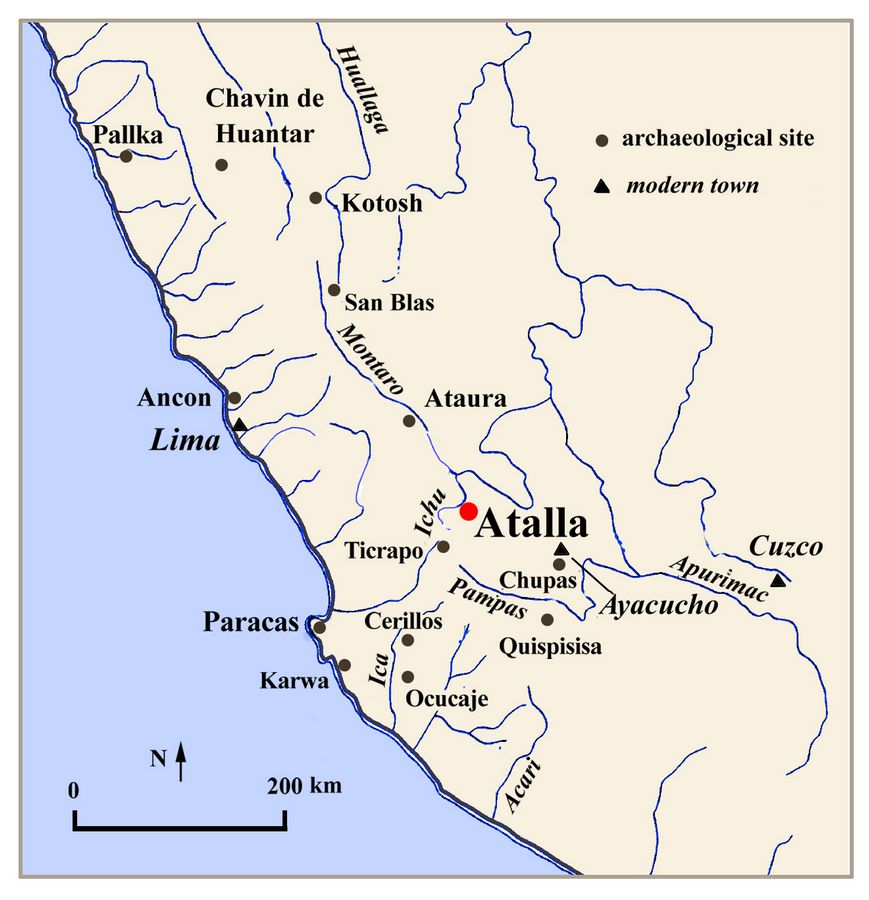 Importance
of the Project
Importance
of the Project This project explores the role of long-distance exchange networks in the emergence of complex society during the Early Horizon period at Atalla, near Huancavelica, Peru. The site of Atalla is located in Yauli, near the Ichu River and about 150 km NW of Ayacucho (fig.1).
Fig.1: Location of Atalla in Peru
Atalla contains diagnostic pottery and other dated occupational evidence from the Late Initial period (1000-800 BC), Early Horizon (800-200 BC) and Early Intermediate (200 BC-AD 200) periods. Pottery types and other decorative motifs and materials including use of cinnabar pigments show definite links with the major ceremonial center of Chavín de Huántar, located in Ancash in the north-central Andes, about 500 km NW of Atalla.
Previous Research
Atalla is divided into five (5) general sectors that were originally defined by the works carried out by the Archaeological Research Project Atalla in the 2014 season (fig.2):
1) Orjon Cancha, the public sector, located in the northeastern part of the site and defined by the presence of a monumental building composed of a sequence of platforms with interior canals that offers drainage to the construction.
2) Achka Wasikuna, the domestic sector, which is located throughout the southern part of the site, where the highest density of cultural material finds and vestiges of rustic stone buildings have been identified.
3) Sumaq Wasi, an elevated sector located in a place of transition between the public sector (Orjon Cancha) and the residential sector (Achka Rumikuna). This sector presents some monumental platform constructions and houses but in lower densities. The seasons 2014 and 2015 revealed evidence of an Early Horizon period house and a lithic material workshop in this area.
4) Hornopata, the sector used mostly during the colonial period, located on the north, west and south peripheries of the site, where colonial buildings and mercury processing furnaces are located.
5) Waqta Rumikuna, the agricultural sector, located on the whole slope of the hill that goes down toward the east of the site, where there are terraces with retaining walls of stones and relatively few scattered archaeological materials.
 Units 1-5 were excavated in 2014, and units A, B, C, D, F, G, H, I J K, and N were excavated in 2015 (fig.2)
Units 1-5 were excavated in 2014, and units A, B, C, D, F, G, H, I J K, and N were excavated in 2015 (fig.2)Fig.2: Site Map of Atalla. Units excavated in 2016 are shown in red.
Project Funded in 2016 [RFF-2016-05]
Goals:
1. Assess the nature, intensity and scale of trade and other forms of interregional interaction at Atalla during the Early Horizon period
This was possible through ceramic, microbotanical and zooarchaeological analyses. Further analyses in the form of petrographic evaluation of ceramic sherds, XRF and INAA analysis of obsidian and isotopic analysis of camelid teeth will reveal more aspects of this question.
2. Clarify the relationship between Atalla and the ceremonial center of Chavín de Huántar, located in the north-central Andes
This was possible through finds made during the 2016 excavations, as well as ceramic analyses. Further analyses in the form of petrographic evaluation of ceramic sherds will reveal more aspects of this question.
3. Test core-periphery hypothesis proposed by Burger and Matos (2002), which states that a demand for cinnabar from Chavín de Huántar stimulated the sociopolitical development at Atalla.
This was possible through finds made during the 2016 excavations, as well as ceramic analyses and XRF analyses of red pigment from ceramic containers and stone implements.
Methodology:
Field and lab work were carried out simultaneously between June 1st and Aug 24th, 2016. Between January 6th and March 6th of 2017 there was a follow-up laboratory season in Yauli, Peru, with a limited group of specialists to analyze the 2016 materials. In March of 2017, samples including 73 ceramic sherds, 10 radiocarbon samples, 2 human bone samples, 36 animal bone samples and 52 obsidian samples uncovered during the 2015 season were brought to the United States for further testing. Three of four carbon samples and one bone sample sent to Beta Analytic have yielded AMS dates in the range of 900-800 BC. The ceramic fragments have been prepared as thin sections sent to Dr. Isabelle Druc for petrographic analysis.
Excavation Units:
The 2016 season opened five (5) new units at the site of Atalla: three (3) in Orjon Cancha, one (1) in Sumaq Wasi and one (1) in Achka Wasikuna (fig.2).
Unit M is located in eastern edge of the sector Orjon Cancha on the top of a monumental platform wall. It encompassed the base of the top of a stone terrace and was oriented parallel to the platform wall. The dimensions were 3m x 3m, covering a total area of 9m². This unit revealed the construction techniques for the creation of the monumental platform upon which the Early Horizon period temple is constructed. Many unusual and finely made ceramic fragments were found here.
Unit Q is located on the corner of the upper platforms which form the top of the Early Horizon temple, located in the sector Orjon Cancha. It was aligned from north to south and measures 2m from west to east x 4m north to south, reaching a total of 8m². Unit Q was oriented to cross three different platforms of the Early Horizon temple. This unit revealed the sequence of construction events to create the temple and the presence of a subterranean canal.
Unit R is located in the center of the uppermost platform in the sector Orjon Cancha. It was oriented on the northwest-southeast axis of the platform complex and joins with the northeast end of Unit B of the 2015 season. The dimensions were 3m x 4m, with a total area of 12m². This unit confirmed the absence of a sunken plaza on the top of the platform mound and revealed evidence of ritual activities.
Unit T represents the largest unit excavated in 2016 and is located in the sector Sumaq Wasi. Unit T is an extension of Unit N of the season 2015 where an Early Horizon wall was found. Unit T encircles the original Unit N for 3 meters on each side to the north, west and south. Unit T was oriented on a N-S axis with dimensions of 6m from west to east and 9m from north to south, minus the area of 9m² of Unit N, reaching a total of 45 m². Although the continuation of the building identified in Unit N was not found, this unit offered insights into early domestic practices. A burial was also found in this unit.
Unit V is located in the sector Achka Wasikuna and represents an extension of Unit I of the season 2015. It is oriented from north to south and measures 3m x 3m with an additional 1m x 1m area towards the northeast side, where it joins with Unit I of the season 2015, covering a total area of 10 m². This unit provided a clear stratigraphic sequence of domestic occupation from the Initial period through the Early Intermediate period. This unit also offered special finds which indicate connections between Atalla and the distant site of Chavín de Huántar.
Results:
Ceramic analysis included 4,405 diagnostic pottery sherds excavated during the 2016 season from the three sectors: Orjon Cancha, Sumaq Wasi, and Achka Wasikuna and from all units (M, Q, R, T, and V) and all investigated layers. These ceramics give evidence of occupation of the Late Initial period (1000-800 BC), Early Horizon (800-200 BC) and Early Intermediate (200 BC-AD 200) periods at the Atalla site.
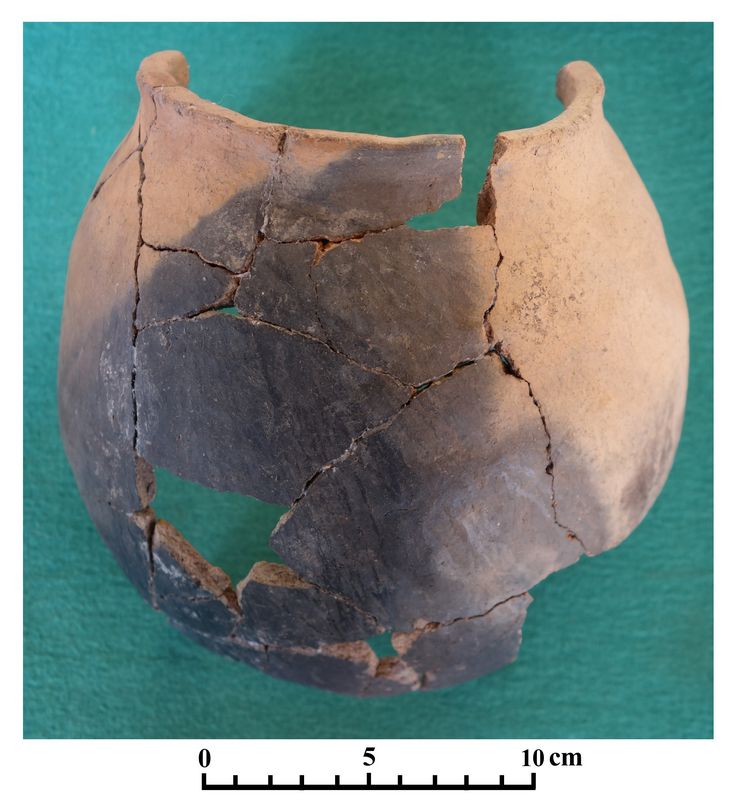
Neckless pots dominate the characteristic forms of the Initial period; open vessels such as bowls with flat and convex bases and globular pots with convex bases and short and everted neck are also present (fig.3). Rim forms are mostly round, but can also be flat. A group of decorated pottery that appears in the deepest layers in the Achka Wasikuna and Sumaq Wasi sectors is the "Atalla" style (Young, in press), defined in the 2015 season but clarified significantly through the 2016-2017 field and lab season.
Fig.3: Short-necked domestic cooking pot from Unit T in Sumaq Wasi.
The Atalla style is a local style with strong ties to the pottery of the central and south-central highlands (Young, in press). The most common vessels of this style are open bowls and short-necked pots. The common decorative techniques include: red paint, natural or red slip, appliqués, punctation and excision. This ceramic style appears to be Late Initial Period in date (c.1000-800 BC).
During Early Horizon (800-200 BC), the pottery changes to include beveled rims and tubular handles, which were previously missing from the assemblage. In the de
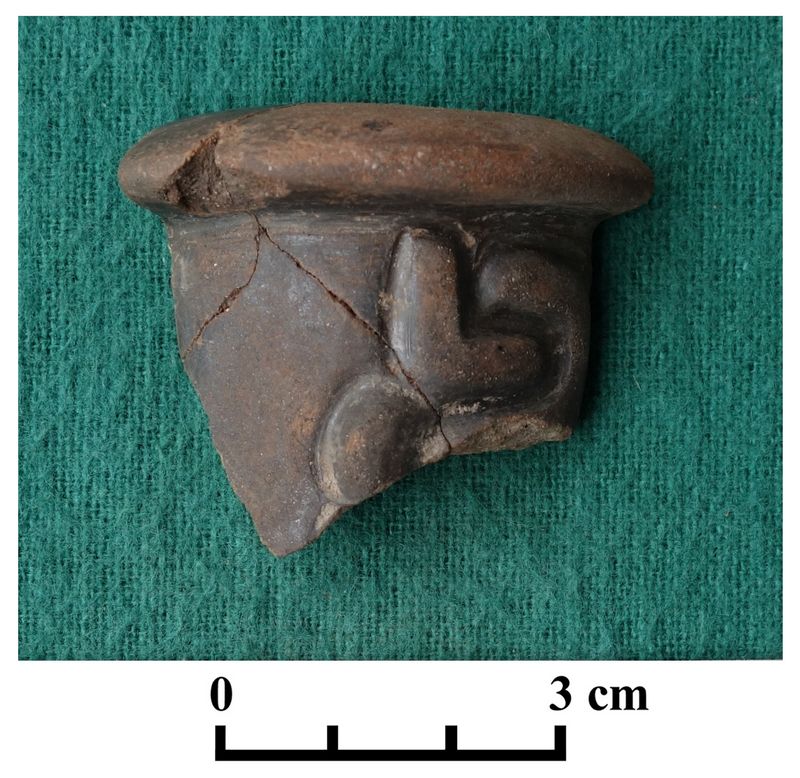 coration, pre-fire and post-fire incision, punctation,
rocker-stamping, dentate rocker-stamping, zoned texturization and
pattern burnishing are introduced. When a post-firing incision appears,
it usually appears inside the vessel and the incisions are often
decorated with cinnabar pigment.
coration, pre-fire and post-fire incision, punctation,
rocker-stamping, dentate rocker-stamping, zoned texturization and
pattern burnishing are introduced. When a post-firing incision appears,
it usually appears inside the vessel and the incisions are often
decorated with cinnabar pigment. Fig.4: Bottle spout fragment in Chavín style with applique and incised avian motif (Orjon Cancha, unit M).
The most representative ceramic motifs of the Early Horizon period (800-200 BC) include incisions of concentric circles, circles with central dots, and curvalinear motifs of anthropomorphic figures (fig.5). There are also some examples of bas relief / sculptural designs with anthropomorphic motifs in the Atalla assemblage.
A significant group of fragments shows important parallels with the ceramic style of the site of Chavín de Huántar, in Ancash, specifically with Janabarriu ceramics (e.g. Burger 1998; Burger and Matos 2002; Young and Fuentes, in review). Most of the Janabarriu style ceramics have a black color produced by reduced oxidation. In light of the comparative distance between the Chavín de Huántar and Atalla sites, the presence of stylistic similarities of the Janabarriu pottery of Chavín de Huántar with that of Atalla suggests a very strong connec
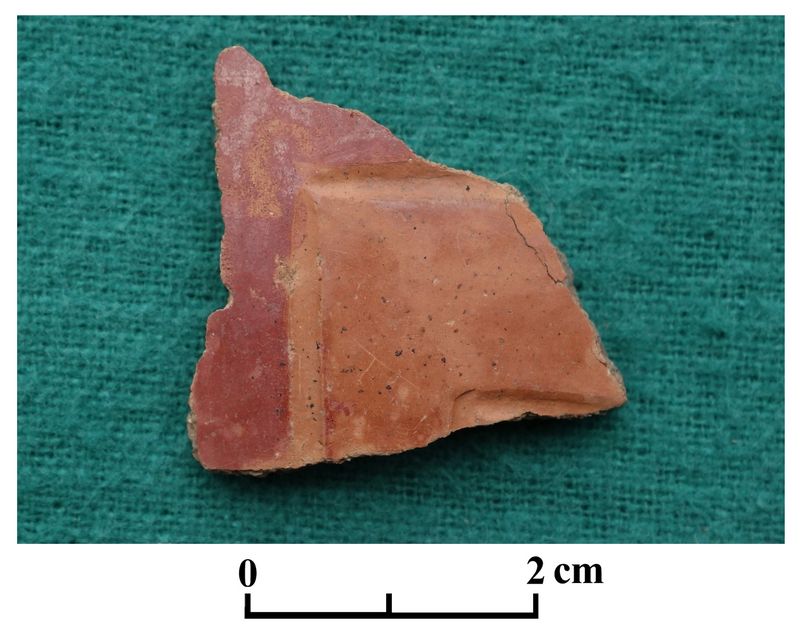 tion between sites. Since ceramics of non-local styles appeared
both in the domestic zone and in the temple, this indicates that
although imported fine ceramics were likely used in public rituals,
local people also obtained foreign pottery for private use to signal
their status and identity as persons connected with distant societies.
A complete petrographic analysis will reveal which vessels were
actually imported and which were produced by local craftsmen to imitate
non-local styles.
tion between sites. Since ceramics of non-local styles appeared
both in the domestic zone and in the temple, this indicates that
although imported fine ceramics were likely used in public rituals,
local people also obtained foreign pottery for private use to signal
their status and identity as persons connected with distant societies.
A complete petrographic analysis will reveal which vessels were
actually imported and which were produced by local craftsmen to imitate
non-local styles. Fig.5: Decorated ceramic from Orjon Cancha, Unit Q.
A high frequency of ceramic fragments from Early Horizon layers were identified with red pigment (cinnabar) as decorative technique. Other fragments, primarily of plates and bowls exhibited pigment adhered to the inner surface, suggesting that these vessels were used for storing and/or processing cinnabar pigment. This observation supports the hypothesis that Atalla assumed a prominent role in the exchange of cinnabar during the Early Horizon period.
Lithic analysis
Dr. Barbara Jane Stone carried out an analysis of 754 lithic objects with a total weight of 9.9 kilograms. For reasons of time, the pieces analyzed came from only 2
 excavation units: R and V to capture a representative
sample of the ceremonial and domestic sectors and a chronological range. Types
of raw material observed were: quartz, fine grain quartz, obsidian,
sedimentary rocks, silicates, and other volcanic stones (fig.6). Also found
were metamorphic rocks classed as green stone, including an earspool
fragment (fig.7).
excavation units: R and V to capture a representative
sample of the ceremonial and domestic sectors and a chronological range. Types
of raw material observed were: quartz, fine grain quartz, obsidian,
sedimentary rocks, silicates, and other volcanic stones (fig.6). Also found
were metamorphic rocks classed as green stone, including an earspool
fragment (fig.7). Fig.6: Fragment of a bowl made of volcanic stone (Achka Wasikuna, Unit V).
Obsidian represents a much smaller percentage of the total (4.5%), while the silicate and other local materials form the greater part of the assemblage sample (95.5%). A total of 34 obsidian items were identified from both excavation units and were comprised of mostly flakes (waste), produced from the reuse of broken tools. Only 7 of the artifacts of obsidian (20.6%) were tools. There is no known source of obsidian in the local area.
The highest percentage of stone tools were silicates such as flint, chalcedony, and jasper, totaling 612 specimens or 81.2% of the total sample and present in high concentrations in both units. A total of 24 quartz flakes and tools (3.2% of the total sample) were found in both of the excavation units. Sedimentary rocks, used for percussion tools and occasionally as scrapers included 39 examples, or 5.2% of the total sample. Volcanic rocks other than obsidian included 41 artifacts, 5.4% of the total sample, also found in all units. Some are flaked tools, includ
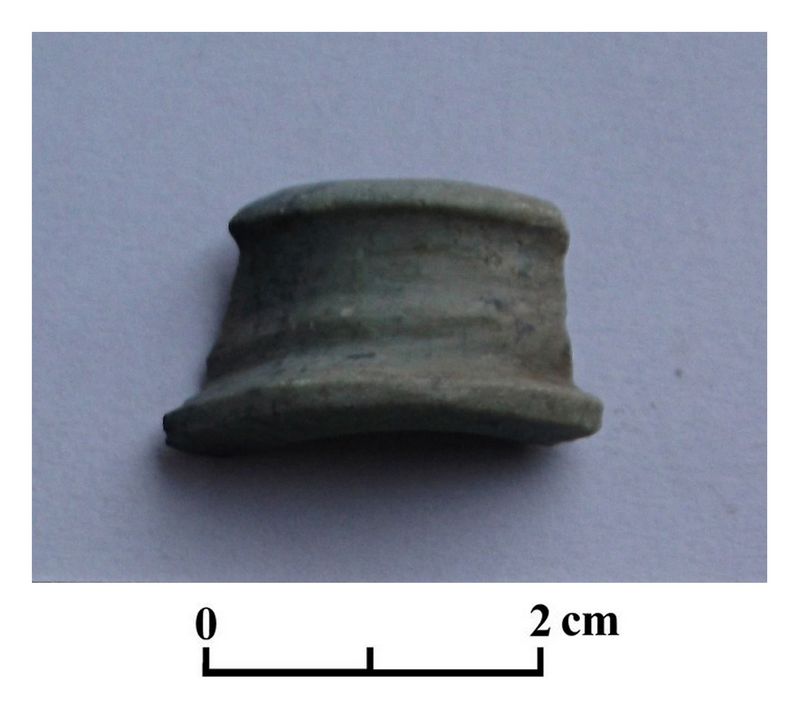 ing
scrapers, and others are cobbles used for percussion (fig.8).
ing
scrapers, and others are cobbles used for percussion (fig.8).The frequency of nonlocal material is very low (7.7%) in the public sector (Orjon Cancha), with even less (3.1%) in the domestic sector (Achka Wasikuna). In terms of chronological changes, there was no clear pattern. What is clear is that the ancient settlers preferred to use obsidian for specific functions, but in a low percentage, in all periods of occupation and that obsidian from a source at a great distance was considered to be worth acquiring.
Fig.7: Fragment of green stone ear spool fragment, Achka Wasikuna, Unit V.
The majority of cores or nuclei found in Atalla were mostly small, worn, irregular and multi-directional, indicating that they are the product of the last phase of nuclei reduction. The fact that almost all cores are completely worn out indicates that the residents carefully curated their lithic raw material. There are a small number of cores of very formal patterns that perhaps represent the work of some craftsman with more knowledge. There are also small numbers of materials and types of tools (such as corrugated scrapers, prismatic blades, and sherataki cor
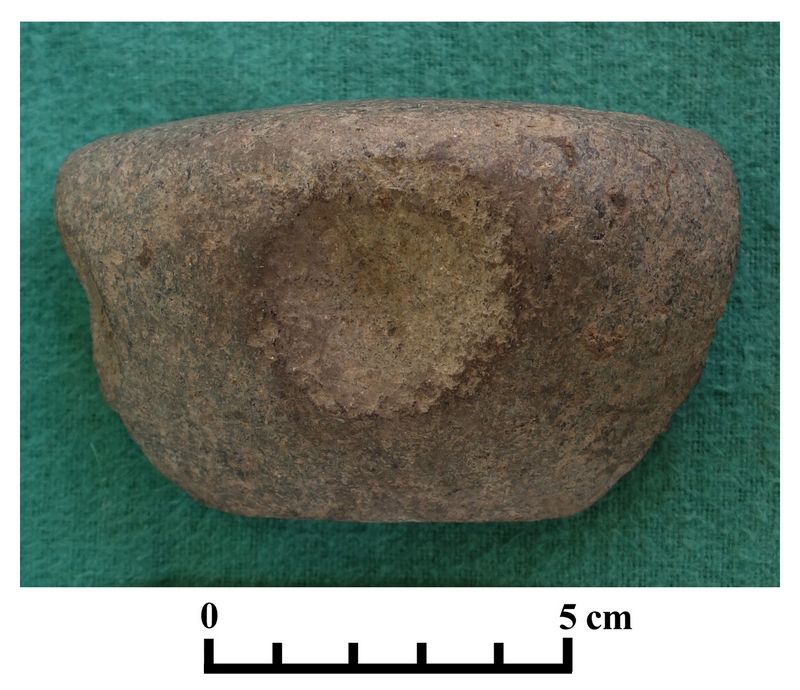 es) that
suggest specialized knowledge. Additionally, thermal alteration of raw
materials, also suggesting elevated techniques of lithic production,
occurred in both sectors, averaging 12.8% in the public sector and
36.5% in the domestic sector.
es) that
suggest specialized knowledge. Additionally, thermal alteration of raw
materials, also suggesting elevated techniques of lithic production,
occurred in both sectors, averaging 12.8% in the public sector and
36.5% in the domestic sector.Fig.8: Mace head or digging weight of volcanic stone (Achka Wasikuna, Unit V).
The tools identified were mostly for cutting or scraping and projectile points were only found in small numbers in both sectors of the site. This observation in conjunction with the relatively low proportion of deer bone compared to camelid bone indicates that the hunting of wild deer was infrequent and deer made up a smaller proportion of the diet than the consumption of domesticated camelids.
Faunal analysis
Sadie Weber performed an analysis of 6,025 fragments of bone material excavated
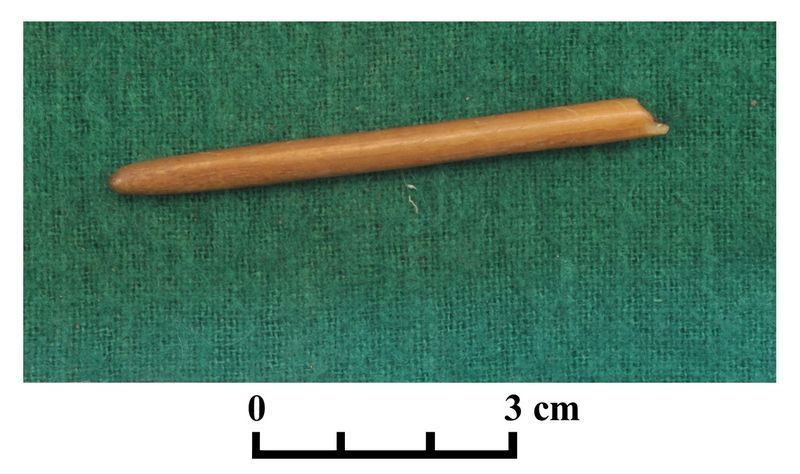 during the 2016 season from the three sectors: Orjon Cancha,
Sumaq Wasi, and Achka Wasikuna. Skeletal elements, conservation status,
taphonomic processes, species (when possible), and the approximate age
of the animal were identified. Usually, animal bones are well preserved
and could be easily identified.
during the 2016 season from the three sectors: Orjon Cancha,
Sumaq Wasi, and Achka Wasikuna. Skeletal elements, conservation status,
taphonomic processes, species (when possible), and the approximate age
of the animal were identified. Usually, animal bones are well preserved
and could be easily identified.Fig.9: Polished bone tool from Sumaq Wasi, Unit T.
Camelid bone was present in each layer of all three of the investigated sectors. Although it is impossible to determine the specific species of camelid, most are medium to large in size, a range that likely corresponds to domestic camelids, such as the llama and alpaca. The category of "medium-sized mammal" was also included a
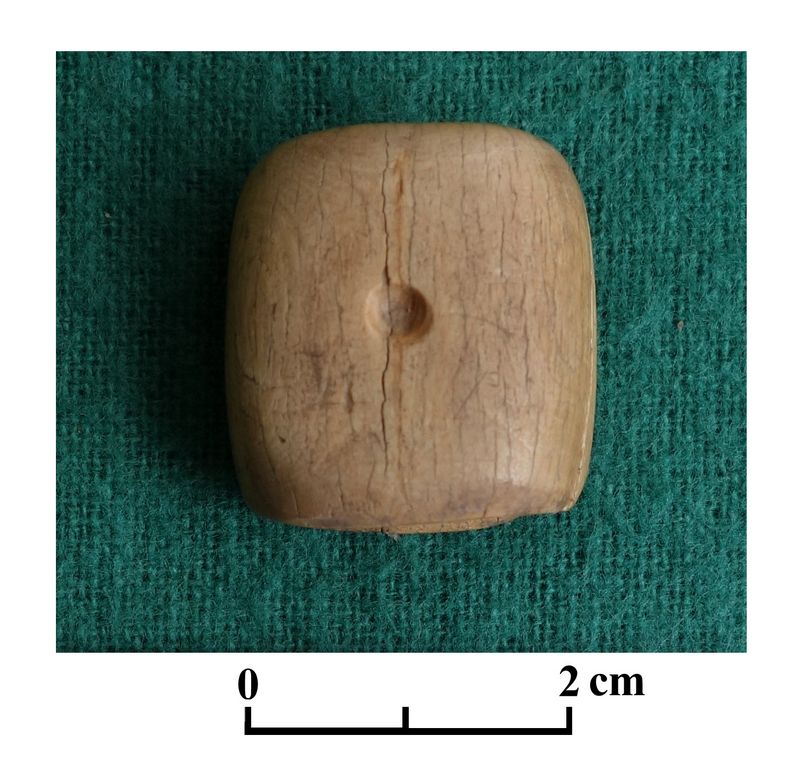 s a category for bone fragments that could
not be distinguished between camelid and cervid.
s a category for bone fragments that could
not be distinguished between camelid and cervid. Camelids represent the largest taxonomic category in the collection of bone material. Each stage of age is represented, between neonate and adult. Also depicted are each skeletal element of the camelids. These results suggest that a portion of the ancient population near the monument was dedicated to grazing llamas and / or alpacas.
Fig.10: Animal bone bead from Achka Wasikuna, Unit V.
Osteological analysis
Human bone was also found during the course of the investigations. In Unit T, a funerary context (CF 1) was found that contained the almost complete articulated skeletal remains of one individual, which was analyzed by Daniela Wolin. Because of its stratigraphic location, it likely belonged to the Early Intermediate period. The individual was between 5 and 7 years old at the time of death. Age estimation was based primarily on evaluation of dental development and eruption. Sex cannot be estimated because of the individual's young age. Linear enamel hypoplasia in the permanent dentition indicate health and diet stress during childhood. The individual also exhibited an unusual congenital deformity.
Conclusions
The results of the 2016 season of the Archaeological Research Project Atalla managed to answer many of the questions raised by the research. First, the excavations illuminated the chronology of the site, verifying that the site was founded during the end of the Initial period and suggesting that the Caja style may have begun earlier than Andean scholars had previously understood. Four AMS radiocarbon dates have confirmed a late Initial period date (900-800 BC) for both the construction of the temple as well as the domestic occupation in the residential sector of Achka Wasikuna.
Second, a significantly improved understanding was gained of the subsistence strategies used by the inhabitants of Atalla, which included agriculture and raising camelids, supplemented by occasional hunting of deer. Notably, access to obsidian did not change much over time, an observation which suggests that the mechanisms used to obtain obsidian may not have been related to long-distance exchange. Possibly, regional obsidian exchange networks were established in the Initial period and remained fairly consistent during the following periods. Alternatively, inhabitants of Atalla may have traveled to sources to acquire their own obsidian without relying on regional networks. Geochemical analyses (INAA and XRF) of obsidian flakes and tools should provide a better picture of if and how Atalla residents participated in trade of this coveted resource.
Finds from the top of the Early Horizon temple (Unit R) have provided insights into the rituals performed there. These include playing musical instruments (with small double-chambered panpipes), the consumption and/or offering of a fermented beverage made of corn and carob bean beer in rare and unusual decorated ceramics, and the inhalation of hallucinogenic powder (using the polished bone spatula fragment). These practices, along with the construction of subterranean water canals like the one uncovered in Unit Q indicate a connection with northern centers such as Kuntur Wasi and Chavín de Huántar. A special find of a carved bone pendant from Unit V bearing elaborate Chavín iconography also confirms a direct connection between Chavín de Huántar and Atalla. With the microbotanical results, we have also been able to confirm that Atalla residents not only potentially participated in the trade of obsidian, minerals, and ceramics, but they also brought in plants such as cassava and carob that came from lower elevation areas.
Finally, there is abundant evidence of cinnabar pigment storage and processing at Atalla during the Early Horizon period, from the presence inside bowls and even vessels designed specifically for the storage and processing of cinnabar (thick plates with thickened edges). These findings support the hypothesis that Atalla residents participated in the export of this resource to Chavín de Huántar and other commercial partners with caravans of llamas that they raised there.
A complete petrographic analysis of the ceramic pastes from 73 sherds exported in March of 2017 will provide a clearer picture of the trade of ceramic wares and the relationship between Atalla and Chavín de Huántar.
References:
Burger, Richard L. 1998. Excavaciones en Chavín de Huántar. Pontificia Universidad Católica del Perú, Fondo Editorial.
Burger, Richard L., and Ramiro Matos Mendieta. 2002. “Atalla: A Center on the Periphery of the Chavín Horizon.” Latin American Antiquity 13(2): 153–177.
Young, Michelle E. (in press). “De la Montaña al Mar: Intercambio entre la sierra centro-sur y la costa sur en el periodo Horizonte Temprano” (From the Mountain to the Sea: Exchange between the south-central highlands and the south coast in the Early Horizon period) Conference proceedings from the II Archaeology Symposium of the South Coast of Peru. Boletín de Arqueología PUCP (22), Lima, Peru.
Young, Michelle and José Luis Fuentes (in review). "Chavín en Huancavelica: Investigaciones recientes en el centro del periodo Horizonte Temprano Atalla" (Chavín in Huancavelica: Recent investigations at the Early Horizon period center Atalla) Conference proceedings from the III National Congress of Peruvian Archaeology, Ministry of Culture, Lima, Peru
.
Recent Foundation grants: general Archaeology Grants Program w/map
Copyright © 2018 Rust Family Foundation